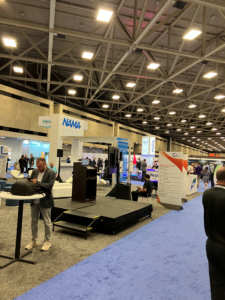
If you weren’t able to attend the NAMA conference in Dallas the week of May 6, I have some of my own observations to share. I’ll begin by thanking NAMA for the opportunity to be involved: I appreciated being asked to present findings from our recent micromarket study I added link to study page and to give insights related to the opportunities in foodservice segments. Now onto my impressions:
Themes in the Sessions
The common thread throughout the entire show dealt with Micromarkets. Honestly, by the time I spoke on Wednesday morning, we had pretty well kicked a dead horse on the subject.
The transition from vending to a micromarket was showcased throughout the expo and the breakout rooms. If you are a supplier, finding a way to assist your accounts to easily move to a micromarket is one of the best ways to foster and cement a relationship. I bolded the prior sentence. It’s not as easy as it sounds, either.
The Floor – AI and Vending
The trade show floor itself was packed with innovative vending technology. Hot vending machines and technology that allowed for seamless purchasing via mobile payments really stood out.
There were plenty of firms represented from China, Korea and Japan that really highlighted how behind the United States is in terms of vending technology and consumer acceptance.
Colleges Are Not a Fit For Micromarkets?
Another takeaway from my own session was a comment about the challenges of operating an unattended micromarket in a college and university setting.
An audience member explained that while it would seem that a closed environment might work for college students, most of them skirt payment and shrinkage is an issue. “Once a student learns how to, say, scan a single bottle of water and then take five of them, the rest of the campus seems to follow suit.”
I have two sons in college right now, and can attest that, if they find a loophole (even if they have plenty of money on their card), added comma here they will likely share it. (I firmly believe they would not exploit this gap themselves, but they would probably pass on the intel that it exists.
More Away-from-Home Context Would Have Been Great
What I do believe was lacking in the sessions itself themselves and throughout the show was more perspective on away-from-home (beyond what I shared in my own session).
Vending and micromarkets compete for share of stomach – or any other foodservice dollar. I was asked on several occasions in the halls about how convenience services compare to the restaurant industry segments. The imperative to recognize is that The point is, disposable income, employment figures and inflation all play a significant role in any foodservice segment. Thus convenience may be the one and only factor that truly puts micromarkets ahead of any single segment. (C-stores or airports with grab-and-go food share this as an area of critical importance.) Still, micromarkets must deliver on taste of food, eye appeal and speed of service – as any other segment – as part of the convenience that is the key lure.
The Pickleball Tournament
I would be remiss if I didn’t give a shout-out to my partner and Man of the Year Jim Brinton at a pickleball tournament held Monday night for NAMA charities.
We were runners’ up to a stacked doubles team that was top heavy in the (fixed) draw (you heard the sour grapes in that one) But was it fun? Heck yes.
I’d advise other conference organizers to consider recreational events such as this instead of the ho-hum, pre-show cocktail hours where you feel like you’re in a showroom buying a used car or pretending to read an interesting caution tag on a window to avoid awkward interactions. But hey, these are just my observations – not Foodservice IP’s dictum.
Tim Powell is a Principal at Foodservice IP.
Foodservice IP is a professional services firm based in Chicago, aimed at delivering ideas for managers to guide informed business decisions. To learn more about FSIP’s Management Consulting Practice, click here.
Like the content? Sign up to receive our communications.
Recent Comments